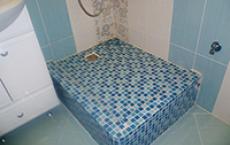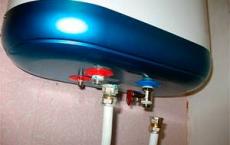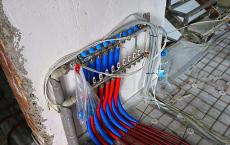Flat ventilation pvc pipe. Ventilation plastic pipes for extraction: the nuances of choice and installation
The laying of communications in a house or apartment is not as simple as it seems at first glance. In order for the equipment to work properly, and also there were no claims of the inspection authorities, it is necessary to make the installation taking into account all norms and rules, not forgetting about the aesthetic component. Consider how diverse the pipes for drawing, understand in their technical characteristics and choose the most the best options installation.
Ventilation pipes with a set of connecting and fixing elements are usually called air ducts. They are designed to provide air circulation and are installed in those rooms where there is no access to natural air movement or there is an additional need for ventilation: in kitchens, in bathrooms, toilets.
Before the appearance of plastic parts in the market air ducts made of galvanized metal, they are now often found in production workshops or in catering establishments (their use is associated with high temperatures).
Stand in a supermarket with plastic elements assembly of the ventilation system for drawing: rectangular and round tubes, adapters, tees, plugs, corner pieces
But for use in everyday life, that is, for installing ventilation in apartments and cottages, polymeric products are more suitable. They have the following advantages:
- they have less weight than metal ones, so they are easier to install with their own hands;
- smooth walls have minimal resistance to air movement;
- they are hermetic, since they do not have seams;
- resistant to high humidity, do not rust;
- on the market you can always find a set of fittings suitable for cross-section.
For the sale allowed products that meet the norms of SNiP and have certificates of compliance, so we can talk about the safety of plastic elements.
Basic characteristics of plastic parts
The properties of pipes need to be known in order to properly design and install a ventilation system in an apartment or house. The characteristics of the elements may differ depending on the installation location (above the ceiling of the plasterboard, in the closet, in the attic) and from the geometry of the room. Let us consider which features become decisive in the selection.
Ductwork material
On sale, you can find products to create ventilation structures of four types of material, which in everyday life is called plastic:
- polyvinyl chloride;
- polypropylene;
- polyurethane;
- polyethylene.
Lightweight, inexpensive, easy-to-install PVC air ducts are the most common material for the construction of household ventilation structures. They are strong, tight, but have some limitations. They can not be heated up to 160 ° C, since harmful for all living chlorine begins to be released, and according to the regulations, the upper heating plate without risk to human health is + 120 ° С.
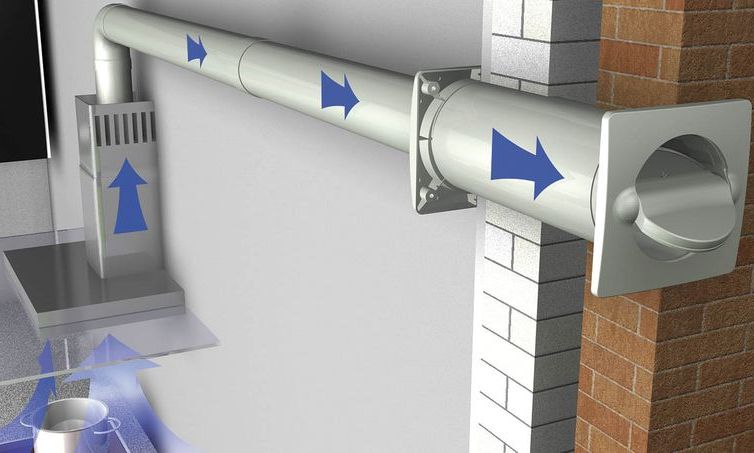
PVC pipes are suitable for installation in the kitchen or in the bathroom, their use is prohibited where there is a possibility of heating up to 160-180 ° C - for example, in saunas or in rooms with a fireplace
When the temperature drops below + 5 ° C, PVC becomes brittle, so for installation ventilation system in rooms with temporary residence it is better to choose another type of pipe, for example, from polyethylene or vinurethane.
Polypropylene is an excellent dielectric, it is not hygroscopic, it has high resistance to aggressive chemical media. The strength limit is approximately 4 times higher than that of polyethylene products high pressure. The main drawback is flammability, the maximum possible temperature is + 85 ° C. However, there is a fire-resistant version with flame retardant additives - PPS.
Polyurethane in its characteristics like PVC, but withstand higher temperatures - up to + 280 ° C.
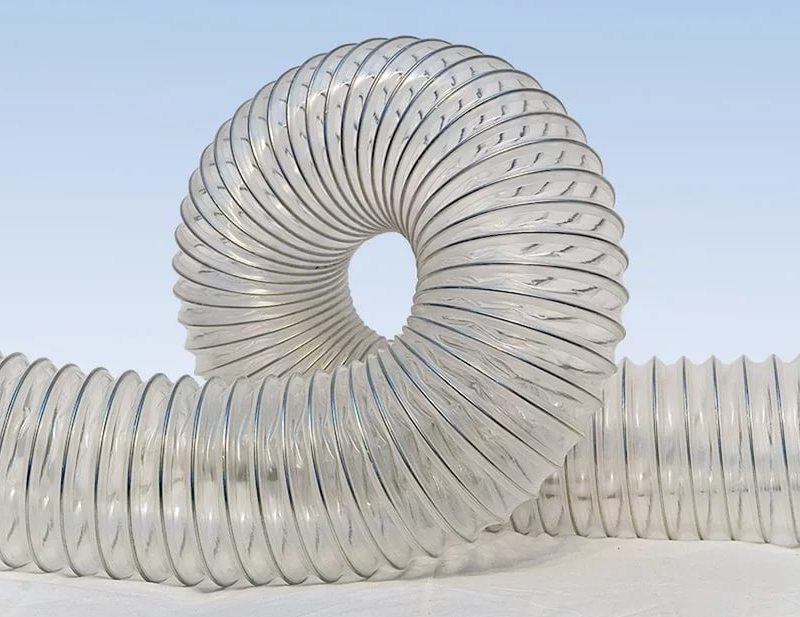
Particularly strong is vinurethane, reinforced with a steel spiral. It is suitable for drawing, because it has excellent resistance to mechanical damage and flexibility, allowing the deployment of the duct from any angle
HDPE - low-density polyethylene. Does not crack with time and, unlike PVC, it is easier to tolerate negative temperatures (actual for houses with temporary residence). Possible heat resistance - up to + 80ºС, cooling - up to -50ºС. Easy to handle, like all kinds of plastic products.
Polypropylene and polyethylene pipes for household ventilation are used rarely, the leading products of their PVC.
Types of pipes in terms of flexibility
There are two categories of ventilation plastic pipes for extraction - rigid and flexible. Sometimes a combined option is required, but much less often. If the hood is installed next to the vent, there is no need for a complex design.
When purchasing rigid round or rectangular cross-section pipes, it is necessary to purchase a set of additional parts to make turns or transition points.

To assemble a short duct for drawing, placed above the kitchen cabinet, rectangular PVC channels and connecting corner elements from a similar material
Along with rigid straight pipes, corrugations are used - flexible products made of polyurethane or aluminum, which allow to do without corner pieces.
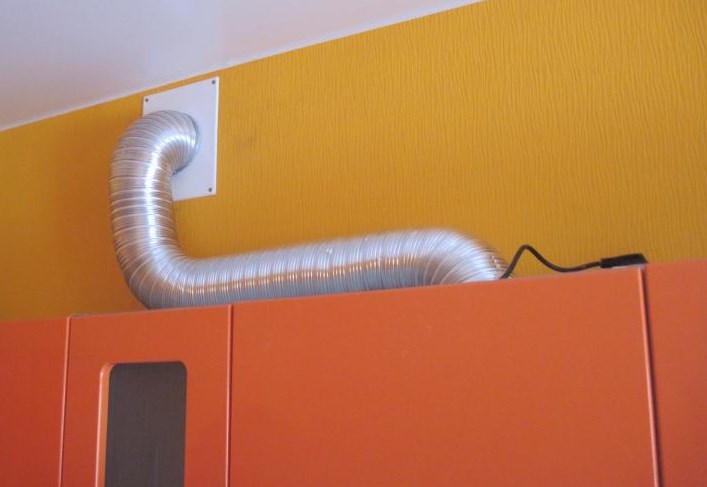
The use of a corrugated aluminum pipe as an air duct has two advantages over plastic analogues: fire resistance and higher strength
Corrugated products are more economical, but lose in design. To preserve the beautiful appearance of the interior, it is better to disguise them under suspended structures or to locate them in a "blind" zone - on cabinets near the wall.
Varieties of elements in the form of section
Depending on the configuration of the pipe, ducts of the following types are distinguished:
- round;
- rectangular;
- flat.
The cross-sectional shape greatly affects the technical characteristics and mounting method. For example, straight round tubes have better throughput and excellent noise insulation, since air, moving along smooth walls, practically does not encounter obstacles (except for the angular sectors). However, due to the cylindrical shape, installation problems may occur.
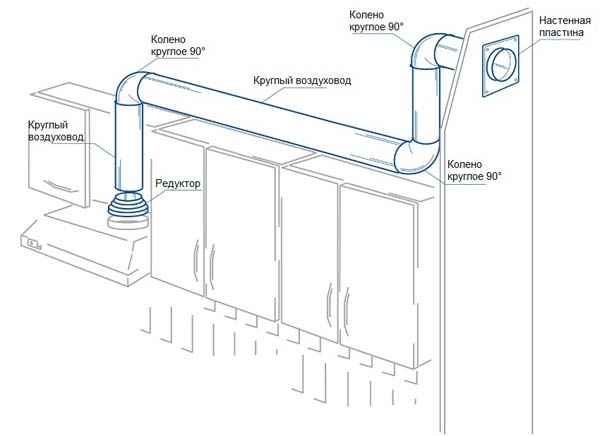
Option for installing a circular pipe leading from the hood to the vent on the adjacent wall. Elements of installation: 4 pieces of pipe, 3 round angular elbows of 90º, reducer (+)
Rectangular ducts fit tightly to any level surfaces (walls, ceiling, walls of kitchen cabinets), so it is much easier to install them. But there is one drawback - the uneven distribution of air, because of which there is a strong noise.

The optimal solution for installing ventilation over a suspended ceiling: light plastic pipes rectangular section with a set of adapters and output round tube (to reduce noise)
Flat ducts are the same rectangular, but having a large difference in the dimensions of the width and height of the section (for example, flat channels 110 mm x 55 mm). Due to the compactness, they are often used for installation in the presence of a shortage of free space (for example, over suspended structures or over highly suspended cabinets).
How to choose the section size
The section size is more important than its shape, since the efficiency of air exchange in the room depends on this parameter. There are standards that take into account the specifics of different rooms, and when choosing the elements of ventilation, it is better to be guided by them.
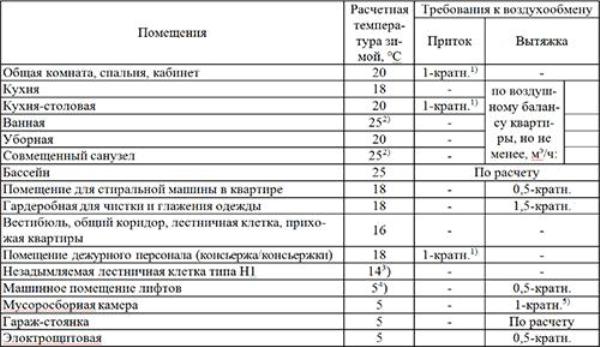
Premises with high humidity and high levels of dirt in the air (bathroom or kitchen) should be ventilated more often and intensively than relatively clean and dry (bedroom, living room) (+)
According to SNIP, the volume of air inflow in houses and apartments should be at least 3 m 3 / hour per 1 m 2 of living space, while the number of people living is not taken into account. The volume of circulating air for people permanently in the room is 60 m 3 / h, temporarily located at 20 m 3 / h (referring to places of work, for example, offices).
It is not possible to make an exact calculation of the cross section by yourself. It is better to use the services of an engineer or a special program for which the following data will be needed:
- form of air ducts;
- material for the manufacture of pipes;
- internal resistance;
- indoor temperature.
There is a way to determine the dimensions of the vent hole for the area of the room. For every square meter of the room, 5.4 cm² of the airway section is necessary, while the pollution factor is important. For an accurate selection of the pipe cross section, we recommend that you contact the professionals who calculate the complex formulas based on the specific data.
What does the exhaust ventilation consist of?
For the installation of ducts, few pipes are needed, fittings are needed - fittings for various purposes. They serve to seal the parts in a single system, provide smooth transitions of pipes of different diameters, connect the air duct with a hood and vent, allow the creation of angles of 90º.
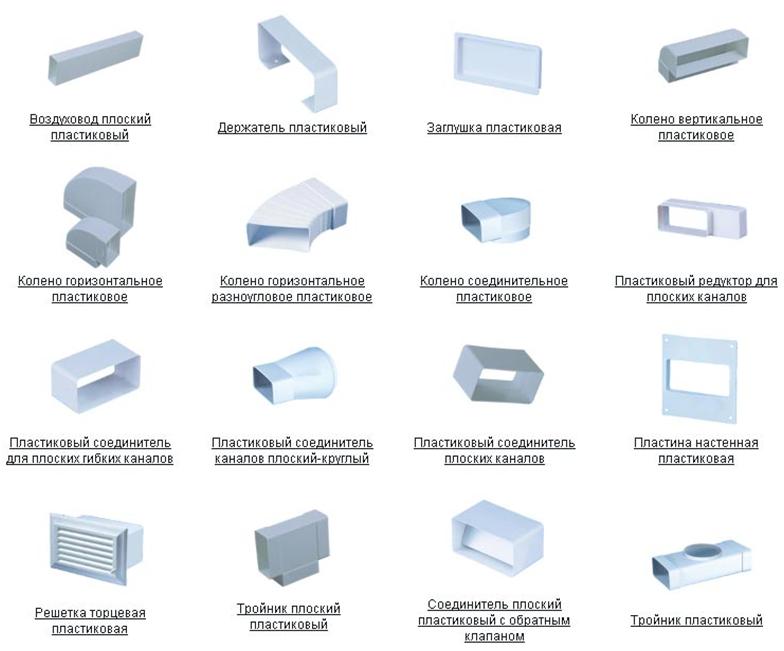
Shaped plastic parts for assembling a rectangular duct: connecting and horizontal elbows, plugs, holders, grilles, reducers, straight connectors, plates, tees
One of the important elements is the transition (adapter). It is necessary in two cases: when it is necessary to connect pipes of different cross-section or ducts that differ in size. Used to assemble structures in rooms of complex geometry, sometimes - for embedded fragments in cabinets.
That there was no effect return thrust and the used air did not return to the room, air ducts are equipped check valve. This is an integrated frame with a dynamic blade that opens only in one direction - in the direction of air flow into the ventilation shaft. The valve does not act as a connecting element, but as a part that increases the efficiency of the ventilation.
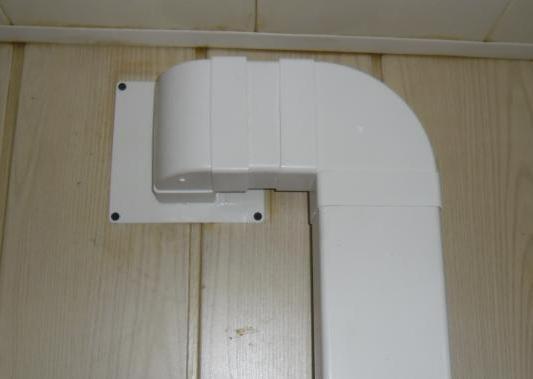
In the assembly of a small segment, two pieces of a tube with a rectangular cross-section are involved, a wall plate, an air duct connector with an outlet and a horizontal angled elbow
To ensure 100% sealing, it is necessary to select fittings strictly according to the dimensions of the pipes: for example, for boxes 150 * 100 mm, knees of the specified size are also needed.
Variants of installation of plastic pipes
Consider two options for installing plastic pipes for exhaust ventilation. They differ both in the place of installation and in the choice of elements.
Installing the duct inside the room
Most often, plastic pipes for ventilation are used in the kitchen to connect the hood and vent located on the wall under the ceiling. For ease of operation, the hob should be positioned as close to the outlet as possible. If it is installed on the opposite side, it is better to move it closer than pulling the duct through the kitchen.
The shorter the overall length of the pipes, the better. It is estimated that each turn of a pipe with an angle of 90º reduces efficiency by 10%, and another as much as one extra meter lose systems longer than 3 meters. That there were no questions on a course of work, we make preliminary calculations and we make the drawing with the instructions of the sizes and additional details of an air line.

As a sample, let's take the often encountered variant, when the outlet ventilation hole is located slightly to the side of the installation site of the hood
You will need:
- flat channel for exhaust ventilation 204 * 60 (1,5-2 m);
- horizontal knee 204 * 60
- connecting knee;
- the plate is wall-mounted;
- round reducer with adapter;
- hacksaw for plastic;
- sandpaper;
- sealant;
- marking tool.
Preparing the pipes - from the plastic boxes cut off the blanks of the required length, we clean the edges. If the air duct is fixed in the free space, you can pre-assemble it on the floor, fixing connecting elements sealant. If part of the structure is in the cabinet, first fix it (reducer + vertical pipe), then connect it to the horizontal pipe with an angled bend.
At the end, connect the pipe to the plate-shaped hole with a special fitting. For strength, anointing joints with a sealant, heating can not be used.

To mask the duct use suspended ceilings or wall cabinets. For open space it is better to choose flat rectangular boxes that become invisible if they are placed on cabinets (+)
If you need to fix the wall or ceiling, you can not use self-tapping screws. For this purpose, specially designed clamps, tightly covering the pipe. They are provided with a rubber seal and are attached using brackets or studs. Some clamps are fixed with a simple click, which simplifies the installation process.
Selecting a suspended ceiling as a masking structure, try to carry out the work qualitatively. Before starting the construction, carefully check the airtightness of the air duct - for repair or replacement it is necessary to disassemble the ceiling structure from plastic panels or plasterboard.
Thermal insulation of pipes in the attic
In the city apartment, the exhaust ventilation system is reduced to the installation of plastic ducts leading up to the hole in the common house shaft. In a frequent home, it does not end there, because there is another segment - from the heated space through the attic to the street. To prevent condensation on the pipes from the cold (the attic is often not heated), they produce insulation.
The best materials for thermal insulation are:
- basalt wool (glass wool, mineral wool);
- shells of polymeric materials - polystyrene or polystyrene;
- expanded polyethylene.
An example of basalt cotton wool is Rockwool, which is non-flammable and rugged, with a minimum air permeability of 0.3 mg / m × h × Pa, a wide range of heat resistance (from-180 ° C to + 500 ° C), hygroscopicity of about 1.5% by volume . Service life is up to 35 years.
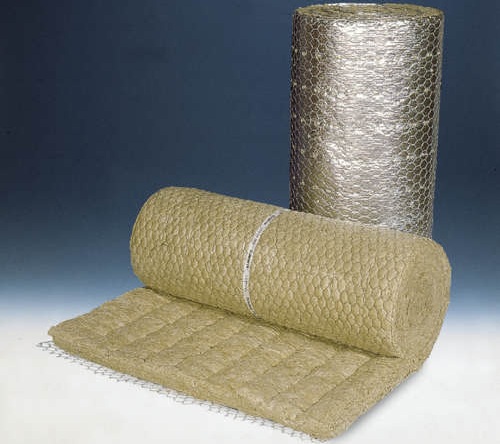
In addition to the roll basalt cotton wool, there are other types of insulation Rockwool: thick mats or plates, rollers with foil coating
Soft rolls are wrapped around tubes with overlap, covered with foil or roofing material on top (if mats are used without waterproofing), fixed with winding metalized tape or steel wire.
Styrofoam and expanded polystyrene look like rigid tubes, consisting of several segments. Some of them are covered with a layer of foil. Polyfoam has a more loose structure, so it is suitable for the insulation of curved fragments. Because of the low price it is preferred by economical owners.

The table shows the comparative characteristics of the shells of PPS, which are made of polystyrene PSB-C and have the form of half-cylinders, fastened by clamps or bandage (+)
Leading positions are foamed polyethylene PenoFol, more elastic than the listed materials. The insulation has a minimum thickness, but it does not allow moisture (one or two sides is covered with a waterproofing foil), provides a low noise level and keeps the heat perfectly.
The thickness of the insulation is different - from 3 mm to 10 mm, the coefficient of thermal conductivity within 0.038-0.051 W / (m * K), water absorption - up to 0.35%. For installation it is enough to cut the material into pieces of the right size, remove the protective film and paste it on the piece of pipe. For straight pipes, large in length, you can use a roll full width, without cutting.
Particular attention should be paid to the places of joints, the outlet area of the duct to the roof, the places of contact with the outer walls.
Video materials on plastic pipes
Informative videos will help you understand the types of plastic pipes and learn more about the ways of their installation.
Installation of plastic box:
Installation procedure in plasterboard box:
Heat insulation of ventilation pipes in the garage:
General information about heaters:
As you can see, the installation of ducts made of plastic is not difficult and suitable for independent work. However, when drafting a project, we recommend that you turn to professionals who know the nuances of the installation combined extract and input ventilation and who can accurately calculate the size of the applied elements.
Do not cease to amaze modern homeowners. At the same time, some skeptics still have doubts: can plastic be compared in strength with metal? We will not speak for the widest scope of plastic applications, but in the manufacture of ventilation systems from plastic pipes, light and strong plastic products will not yield to heavy and bulky metal ducts, and in some cases they will even give them a head start.
Household ventilation from plastic
In conditions of our current reality, ventilation in a private house made of plastic pipes becomes much more profitable than the use of tin and aluminum ducts. The plastic ventilation ducts, both round and rectangular, are pleasantly distinguished by their aesthetically flawless appearance. The buyer can choose products of exactly the color that will be in harmony with the interior gamut in his house. The cost of plastic ducts is noticeably less than their metal counterparts, and the installation of ventilation from plastic pipes by their own hands is extremely simple and is accessible even for non-professionals.
In recent years plastic pipes for ventilation have managed to become leaders in terms of their production volumes and sales figures. This indicates that many customers have managed to assess the reliability of plastic pipes for ventilation and ease of use. We, as consumers, offer not only plastic ventilation pipes for hoods, but in addition to them a complete set of adapters, couplings, plugs, grilles and other components of the system of plastic pipes. Shaped elements of the corresponding configuration allow, if necessary, to mate round ducts with rectangular cross-section.
By the type of material from which they are made, plastic ventilation pipes come in different types, differing in some ways:
- polyethylene - known for their flexibility and durability;
- pVC (PVC) - having a high threshold of flammability resistance and insensitive to UV-radiation;
- polypropylene - characterized by exceptional strength and chemical inertness to aggressive substances.
Plastic ducts for ventilation
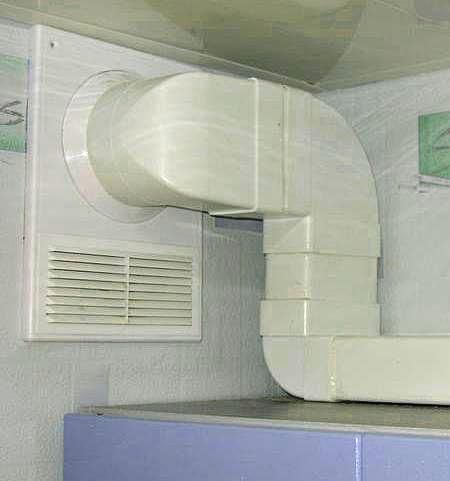
Traditionally, the material for the construction of ventilation ducts in private houses was galvanized sheet metal, aluminum was also used. But since the introduction of lighter and less expensive plastic vent pipes, the preferences of engineers and homeowners were unconditionally given to them.
You can also appreciate a number of advantages that, by virtue of their physical nature, plastic pipes have in contrast to their metal competitors:
- Resistance to corrosion. The main difference between plastic and iron is the absence of rust, so a plastic ventilation pipe for extraction will be indispensable in conditions where dampness is constantly observed;
- Smooth inner surface. Production technology provides plastic pipes for ventilation systems an ideal smoothness. This indicator is especially important, because the slightest roughness of the internal surfaces prevents free movement through the pipes of the air flow;
- Light weight. To bring from the store the entire set of plastic pipes and accessories, you do not have to hire a multi-ton truck. And whatever the size of the plastic pipes, they can be easily lifted and rotated when installing the ventilation system;
- Easy to install and maintain. Mounting parts and components of plastic ducts is much easier than messing with heavy metal boxes. Periodic inspection and cleaning of ventilation ducts will not be difficult for you;
- Comparative cheapness. The cost of inexpensive plastics in comparison with metal successfully solves your problem, how to make cheaper ventilation from plastic pipes.
Plastic pipes are unable to withstand temperatures above 80-90 degrees, therefore it is undesirable to use them for ventilation of such premises as a sauna, a bakery, a boiler room, etc.
The shape and dimensions of ducts made of plastic
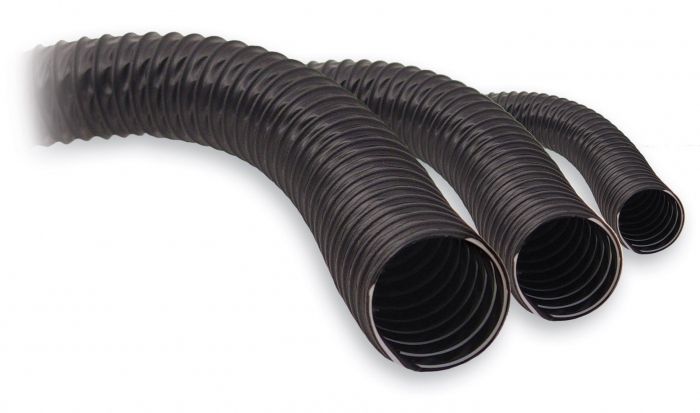
In private houses ventilation is made from plastic pipes round in cross section or rectangular. There is also an intermediate version of air ducts with an oval cross-section. Round air ducts can be not only stiff and smooth, but also corrugated, their flexibility allows the installation of difficult to configure ventilation ducts. The choice of the shape of the duct is determined according to the peculiarities of its location, but the design project also has considerable significance.
Manufacturers produce pipes for ventilation, the dimensions of which make it standard. Unification of the dimensions of the pipes is necessary in order to conveniently select the appropriate fittings for them. For laying the air ducts in an ordinary cottage it is enough to use:
The maximum length of plastic ventilation pipes for sale is up to 2.5 meters, which allows them to be mounted without excessive use of joints.
When planning how to make ventilation from plastic pipes, do not forget that plastic rectangular ventilation pipes create somewhat more resistance to air flow than circular ducts.
How to plan a plastic ventilation in the house
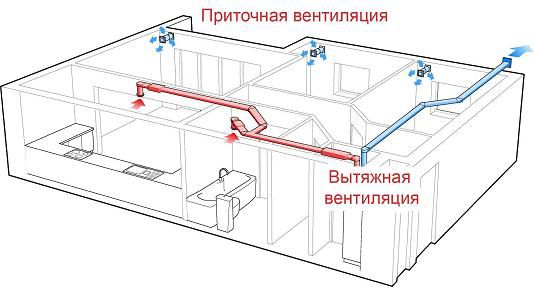
If you decide to build a plastic ventilation pipe at home, take it responsibly. Before proceeding, entrust the design of all putative exhaust elements to an experienced technician. Only a master with experience and skills will be able to accurately calculate the performance of the system and make an estimate.
Together with the designer, discuss a number of important points:
- extraction of exhaust air from various purposes (kitchen, bathroom and living rooms) should occur through separate air ducts;
- to remove condensate from the exhaust ducts, it is necessary to equip special openings in them, even though the plastic pipes used for ventilation are not afraid of moisture;
- if it is not possible to avoid laying out long horizontal sections of ducts, then they will have to be equipped with fans for forced drawing;
- so that the fan does not blow air from one room to another, at certain places in the ventilation system of plastic pipes, check valves must be installed.

When constructing ventilation from plastic pipes, you will certainly have to use couplings, turns, tees and other parts for their connection.
But at the same time, count so that each plastic ventilation pipe runs as smoothly as possible, without unnecessary turns. In the duct system, too, there should not be too many joints, try to use the whole pipes as much as possible. There are two reasons for you to strive for the optimal configuration of ventilation ducts:
- Each of the joints and sharp turns of the plastic pipe for ventilation reduces the air velocity and increases the noise.
- Additional costs for numerous accessories lead to an increase in the cost of the entire system.
Another thing - kitchen chimney Ventilating plastic, designed for drawing. Here, open air ducts are more often used, and so that they do not violate the harmony of design, the pipes for ventilation of the kitchen can be painted, if desired, in the chosen color. In the kitchen, the ventilation of plastic pipes is especially important, and making it with your own hands is not only simple, but also prestigious.
Because the plastic tends to accumulate static electricity, dust and droplets of fat flying from the plate stick to it. Therefore, when installing plastic pipes to ventilate the kitchen, it is advisable to treat them from the inside with an antistatic compound.
Technological aspects of the device of plastic ventilation
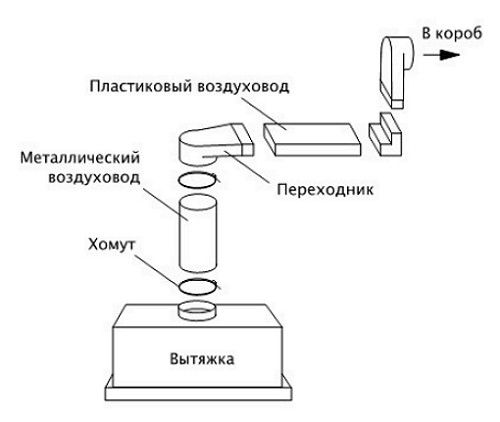
At first glance, the question of how to make self-ventilation from plastic pipes may seem complicated. In fact, it is not difficult to cope with such work. You just need to read some of the recommendations and follow them during the installation work.
- You can cut plastic pipes into pieces of the right size right on the spot where you will mount them;
- Connect plastic pipes in two ways: one-piece (using welding) and detachable (using fittings and flanges);
- For the construction of ducts, it is preferable to use detachable connections to facilitate the possibility of repairing them, if necessary;
- Connect the elements of the duct and their mutual fixation with the attachments and silicone sealant supplied with them;
- Collect complex parts of the system in a convenient place on the floor, and then lift to the installation site;
- Mount the air ducts to the ceiling with special clamps. For light plastic pipes, one attachment is sufficient for the entire solid area. The heavier and larger in size plastic rectangular ventilation pipes will have to be fixed every 1.5 meters.
A video lesson will help you understand the specifics self-assembly kitchen duct.
The organization of a ventilation system that delivers fresh air into the house and expels the waste mass outward, a necessity dictated by the provision of standard sanitary and hygienic standards. The device of supply and exhaust ventilation is a strict requirement in the presence of gas heating. The system with natural circulation air are built in small single-storey houses. Devices for the discharge of air must be installed in the bathrooms, saunas, kitchens, fireplace rooms, if any. Regardless of the method of air exchange, channel-type systems are mainly constructed using air ducts for ventilation, the characteristics of which are worth familiarizing with.
If the device of the ventilation system is made during the construction of the building, they are usually laid in the wall in order not to spoil the interiors with not too attractive communications. It is best if the ducts are located vertically next to the chimneys (no closer than 10 cm), which will contribute to strengthening the thrust. Ideally, if each room has a separate air duct, and they are all combined into one outlet channel. Other wiring schemes are allowed if the rooms are in different parts of the cottage.
If the device of the air exchange system is made in the course of construction, the ventilation ducts are laid in the walls or in the mines constructed for their installation
Attention. The intersection of air ducts with sewer, gas, water pipelines construction standards is prohibited. In the ventilation shafts, you can not lay a sewage pipeline.
Channels can be laid out with a brick or mounted using ready-made pipes for ventilation. The latter method is less time-consuming, it's easier to do it yourself. Most often, galvanized steel or aluminum pipes were used for ductwork. Metal products are now installed in offices, public buildings, in industrial premises, characterized by a high degree of explosion hazard. However, with the introduction of polymer products in various areas of construction, plastic pipes for ventilation have actively replaced the metal counterparts.
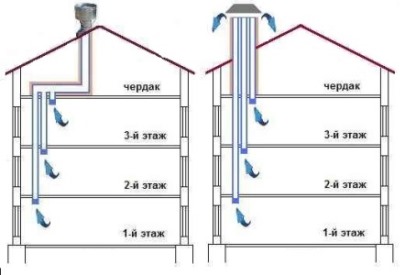
Two versions of the air duct device: on the left - all ducts are combined in common system with one outlet pipe, on the right for each room is installed its own air duct
What is better plastic or metal?
Before we start comparing products from materials with different technical characteristics, we will study the list of requirements for air ducts. After all, the function of metal galvanized products and PVC pipes for ventilation should perform one.
Comparison by technical characteristics
General requirements for ventilation ducts:
- Ensuring perfect tightness.
- Creation of conditions for free flow of a specific volume flow with a given project speed.
- Compliance with sanitary and hygienic standards for the composition of products and the level of noise generated.
- Resistance to burning.
- Maximum combination with the design of premises.
- High insulation characteristics.
To form sealed connections, both plastic ducts for ventilation and metal products are equipped with special flange elements. That is, you can build a system of any complexity from both variants. PVC products and metal pipes are available in different shapes and sizes. Hence, complications with the choice of suitable pipes will not be in both cases. But the insulating characteristics of the innovative material is significantly ahead of the metal, which requires mandatory insulation in the zone of passage through the roof.

In the zone of passage through the roofing structure, the galvanized air ducts must be insulated to prevent the formation of condensate, which corrodes the metal, the plastics are not afraid of accumulation of moisture
Non-combustible galvanized pipes for ventilation are indispensable for the construction of an air exchange system in hazardous production workshops with the threat of fire. However, for the arrangement of housing with standard operating conditions, they are not required, but spoil the interior picture bulky tin ducts may well. In addition, in a metal channel in the case of turbulence, the noise negative amplifies, being reflected from the walls, which does not happen in plastic ducts.
Council. To exclude "twists" with a characteristic sound negativeness, corrugated pipes for ventilation and rigid channels should preferably be paved with a minimum number of turns. Avoid angles of 90º and sharp jumps from one pipe diameter to another.
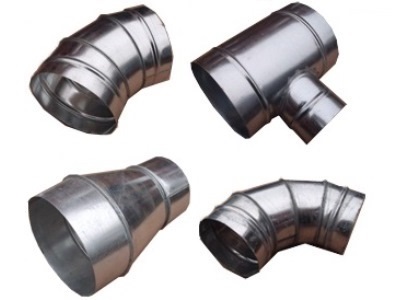
Welded flanges for tin galvanized pipes are necessary for making sealed connections, for making turns with a certain flange model, in degrees, for wiring and changing to another diameter
On the sum of operational advantages, plastic is ahead of the metal, the only drawback of PVC is insufficient fire resistance. In the event that the exhaust pipe for ventilation is installed next to the chimney, it is better to reject polymer products.
Rigid and corrugated channels
Depending on the complexity of the system being constructed, rigid and flexible air ducts are used in the process of its construction. With rigid elements everything is clear, they are in both variations with a round and square section. Round are more beautiful and compact, they are mainly used for ventilation in a country house.
Flexible pipes are needed if in a small section the channel needs to be rotated several times to connect to the main line.
- Metal flexible ducts for the ventilation system are made of multi-layer aluminum foil with a corrugated structure. You can bend them at any angle, but you need to remember that the smooth interior surface creates additional aerodynamic resistance.
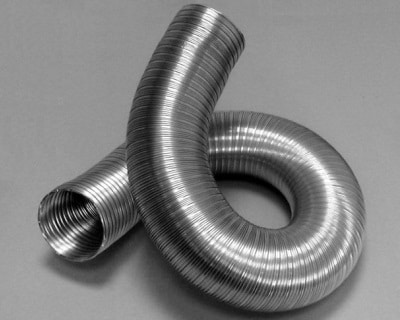
The use of a metal flexible duct allows you to quickly arrange the system and use a minimum number of flanges
- Plastic flexible flexible pipe for ventilation is made of polyester and aluminum foil. The multilayered structure is reinforced with steel wire, laying turns between layers. Now PVC products with increased heat-insulating and sound-absorbing qualities are produced. They are used for laying ventilation ducts in housing.

Plastic corrugated pipes - the most common option for the device ventilation in country cottages: minimum of connections and fastenings, maximum rates of construction
Corrugated products are suitable for laying ventilation ducts with low pressure (800-5000 Pa) and low speed of air flow (30 m / s).
Evaluation from the installer's point of view
It is mandatory to include any ventilation ducts: their installation is inevitable and not easy, but you can choose a material that can reduce labor costs.
- Plastic is easier. This quality is in the priority and in the process of construction, both during transportation and during operation.
- To fix the channels, devices that can hold a large load are not required. The sagging of the channels should not exceed 4%.
- PVC ducts for ventilation by their own hands can be cut freely into the size required for laying a complex configuration. Working with metal is much more difficult.
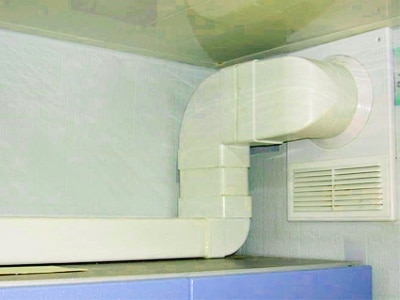
Plastic vent channel easier to build with their own hands, the pipes are easily cut, which makes it possible to make ventilation of any complexity, for the corners and joints there are special elements, a smooth surface does not create obstacles for the air flow, they practically do not need to be cleaned
Will sewers fit?
For laying air ducts, special plastic products with a diameter of 120 mm are produced. According to the structure and composition of the material, they are similar to sewage pipes, but the cost is higher in a five-fold almost size and a diameter of 110 mm. At forums of folk craftsmen, the question of whether ventilation from sewer pipes can be built is actively discussed. Is it possible, for example, to corrugate a plastic with a diameter of 120 mm attached to exhaust pipe, made of sewage pipe?
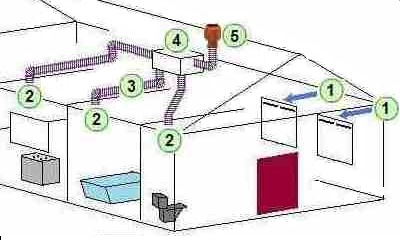
The scheme of forced ventilation: 1) ventilation grilles on the windows for fresh air intake, 2) exhaust openings for exhaust air exhaust, 3) flexible air ducts, 4) control equipment, 5) output device with a diameter exceeding the dimensions of the air ducts
According to the building rules, the output device must be wider. However, many believe that a narrowed by 10 mm pass will not affect the functionality of the system. The main thing, in their opinion, is that the connection is airtight, to ensure that the joint is tightened with double-sided tape and other insulating materials. In general, it is not recommended to switch to another diameter when constructing a ventilation network. And in the place of air removal the narrowed passage will make movement difficult. But if otherwise it does not work out, the transition should be smooth without "steps".
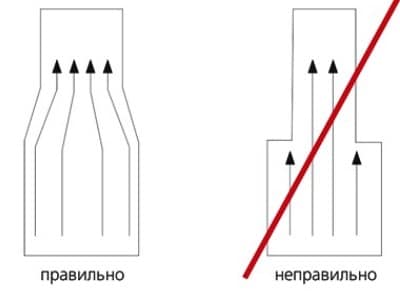
The connection of pipes into a single channel must be smooth without sharp transitions from one diameter to another and "steps"
It's no accident that consumers are switching to plastic products. They are lighter, cheaper, in terms of technological, aesthetic, and operational parameters ahead of outdated metal options. A weighty addition to the pluses is a rare care, because on the smooth surface of plastic with antistatic properties does not accumulate a clogging air duct sediment.

